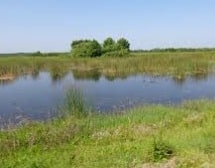 A territory that has shallow groundwater or surface water is called a wetland . Wetlands are usually flat lands that are flooded intermittently or permanently, depending on the case.
A territory that has shallow groundwater or surface water is called a wetland . Wetlands are usually flat lands that are flooded intermittently or permanently, depending on the case.
It can be said that a wetland is a temporary or constantly flooded surface , which is interrelated with the living beings that inhabit it and is regulated by climatic conditions. Swamps , mangroves , estuaries , peat bogs , marshes and swamps are wetlands.
Due to the shallow depth of the water table (the upper layer of the aquifer), the soil regime of wetlands undergoes alterations. Hydrophytic plants function as water filters, storing and releasing it.
According to their morphology, wetlands can be riparian (they are flooded by the overflow of a river ), marine (they do not change according to the river flow), lacustrine (permanently covered by water with low circulation) or estuaries (where a river flows into the sea), among others.
If we take into account their structural type, we can establish a classification that distinguishes two groups by applying a hydrological criterion according to their aspects:
* external : this group includes the hydrowetland , which usually has a sheet of water that emerges throughout the year, and the hygrowetland , which has a hidden sheet of water almost all year round;
* internal : here is the epigenic , a wetland whose structure is not linked to the nearest underground flows, and the phreatogenic , which does present a link between its structure and the nearby flows.
In turn, if we think about the hydrogeological areas of flow, we can subdivide phreatogenic wetlands into wetlands:
* recharge : such as basins, river recharge sections and infiltration ponds;
* transit : such as coastal cryptowetlands and outcropping lagoons;
* discharge : such as seepage areas and puddled springs.
Due to their biodiversity , wetlands are very important for ecology. However, these are lands that are often degraded or lost due to aquaculture , agriculture and industrial development. Faced with this reality, in many parts of the world policies and measures are being put into practice that seek to protect them.
 The Iberá estuaries in Argentina ; the Great Pantanal in Brazil , Paraguay and Bolivia ; the Zapata swamp in Cuba ; the Niger River Delta in Nigeria ; the Daimiel Tables in Spain ; and Lake Chilka in India are among the most important wetlands on the planet .
The Iberá estuaries in Argentina ; the Great Pantanal in Brazil , Paraguay and Bolivia ; the Zapata swamp in Cuba ; the Niger River Delta in Nigeria ; the Daimiel Tables in Spain ; and Lake Chilka in India are among the most important wetlands on the planet .
On February 2, World Wetlands Day is celebrated. This is a festival that was inaugurated in 1997 to commemorate the date on which the signing of the Convention on Wetlands took place two and a half decades earlier in Ramsar, a city in Iran. Another name by which this convention is known is the Wetlands Convention , and its entry into force took almost five years.
The most important objective of the Convention on Wetlands is to conserve these spaces and use them wisely. To this end, a series of actions were proposed, both at the local, regional and national level; Furthermore, through cooperation between several countries, a plan that contributes to sustainable development in all parts of the world becomes possible.
By 2011, 160 states had already committed, protecting more than 1,950 wetlands in various parts of the planet. All of these added up to almost two hundred million hectares, an area that was included in the list of international importance. The experiences and knowledge that each country gathers throughout its work , as well as the progress it makes, are evaluated in meetings that take place every three years.
